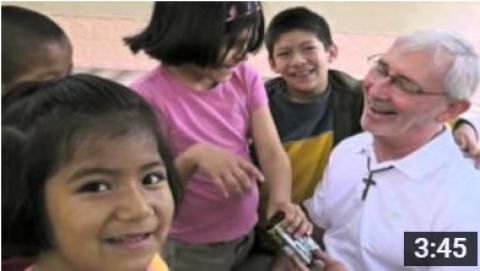
Join the World AIDS Day Prayer Vigil on December 1.
Sign up for a one-hour time slot during the 24-hour vigil.
About World AIDS Day
World AIDS Day is held on December 1 each year around the world. It is an opportunity to raise awareness, commemorate those who have died, and celebrate victories such as increased access to treatment and prevention service.
In 2018, there were 37.9 million people living with HIV, the virus that causes AIDS, “acquired immunodeficiency syndrome." More than thirty years into the epidemic, there are signs of hope for an AIDS-free world.
Since the beginning of the epidemic in 1981, Maryknoll missioners in Asia, Latin America, and Africa have worked in ministries serving persons living with HIV and AIDS. We have accompanied people dying of AIDS, worked with children orphaned by AIDS, supported women and girls who are at risk of violence or sexual abuse, and witnessed the direct impact of debt, trade issues and poverty on societies decimated by AIDS.
Over three decades more than 25 million people have died of AIDS worldwide. The world has responded by committing billions of dollars for research, programs and medicines, and innumerable efforts to change behaviors and lower the number of transmissions. According to the World Health Organization, by the end of 2018, 23.3 million were recieving treatment for HIV, or 62% of people living with the disease.
According to the latest estimates from UNAIDS and partner organizations:
- About 770,000 people died of AIDS in 2018. The numbers are declining; 1.1 million people died of AIDS in 2015. Deaths have declined due in part to antiretroviral treatment (ART) scale-up. HIV remains a leading cause of death worldwide and the second leading cause of death on the African continent.
- There were about 1.7 million new infections in 2018, a decrease from the 2.1 million new infections counted in 2015. These numbers indicate a significant declinein new infections since the mid-1990s.
- HIV has led to a resurgence of tuberculosis (TB), particularly in Africa, and TB is a leading cause of death for people with HIV worldwide. Between 2004 and 2014 TB deaths in people living with HIV declined by 32 percent, largely due to the scale up of joint HIV/TB services.
- HIV is a leading cause of death among women of reproductive age, especially on the African continent. Gender inequalities, differential access to service, and sexual violence increase women’s vulnerability to HIV, and women, especially younger women, are biologically more susceptible to HIV. Data indicates that in 2018, new infections among young women (15-24 years old) were 55% higher than among young men.
- Globally, there were 1.8 million children living with HIV, 110,000 AIDS-related deaths, and 150,000 new infections among children in 2015. Since 2001, new HIV infections among children have declined by more than 70 percent.
- Sub-Saharan Africa, the hardest hit region, is home to nearly 70 percent of people living with HIV but only about 13 percent of the world’s population.
Faith in action:
- Learn more about World AIDS Day at https://www.worldaidsday.org/
- Join the World AIDS Day prayer vigil on December 1. Sign up for a one-hour time slot during the 24-hour vigil.
- Pray with the Maryknoll AIDS Task Force prayer at http://bit.ly/MaryknollAIDSprayer
